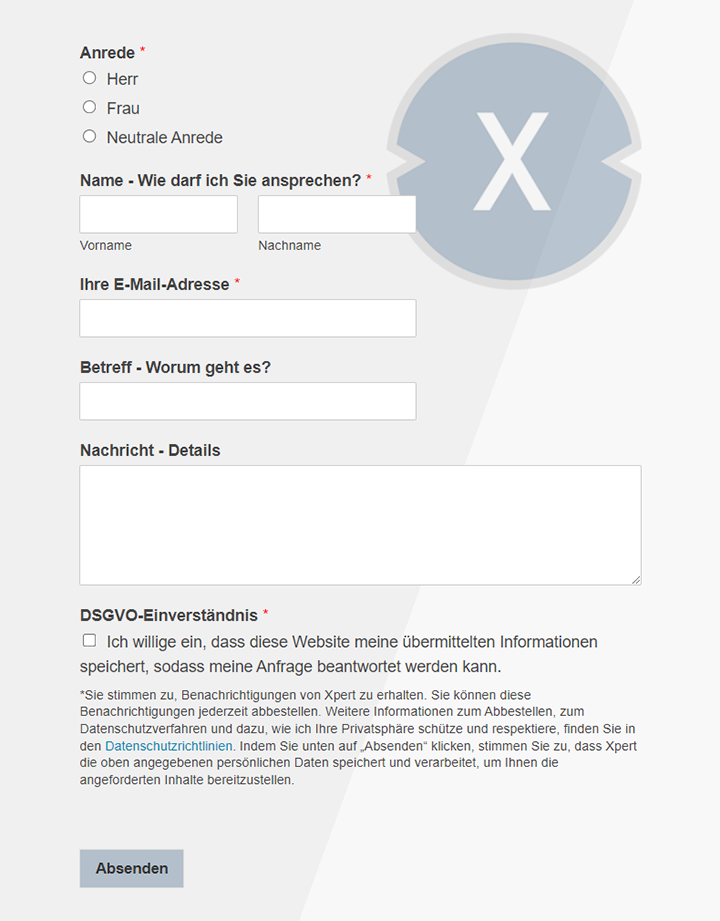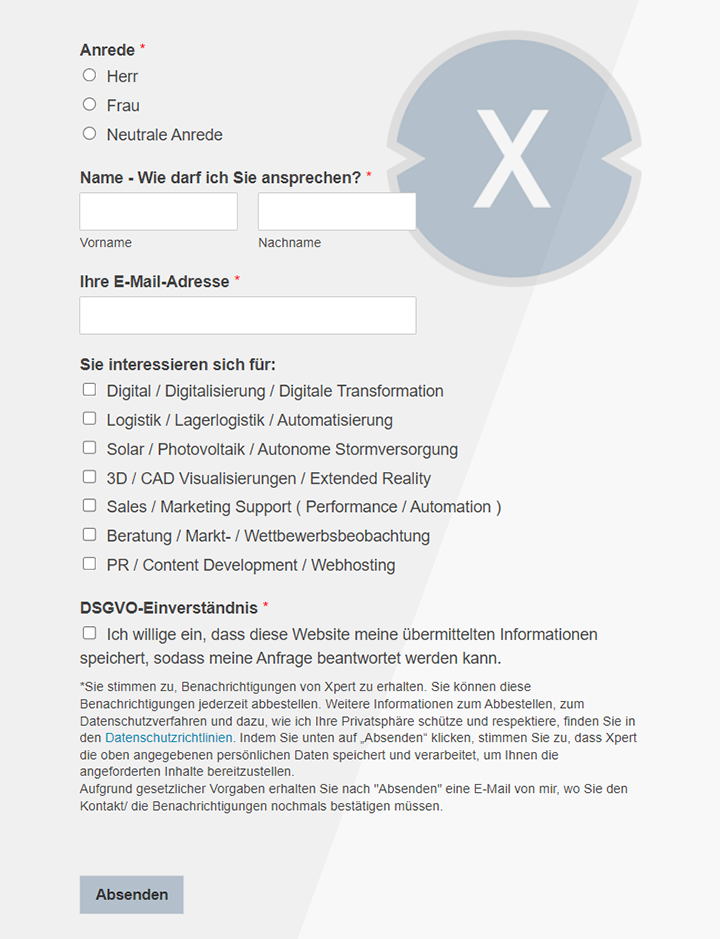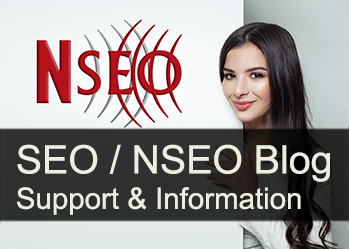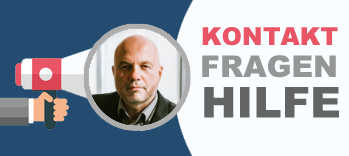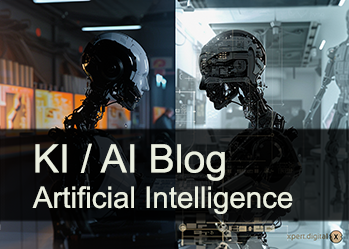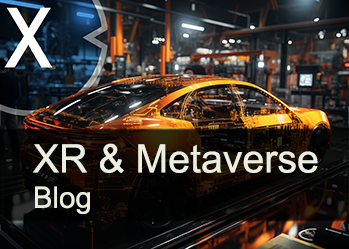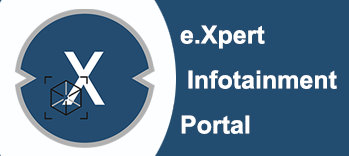The new digital visibility - deciphering of SEO, LLMO, Geo, AIO and AEO - SEO alone is no longer sufficient
Xpert pre-release
Language selection 📢
Published on: June 26, 2025 / update from: June 26, 2025 - Author: Konrad Wolfenstein

The new digital visibility - deciphering of SEO, LLMO, Geo, AIO and AEO - SEO alone is no longer sufficient - Image: Xpert.Digital
A strategic guide for generative engine optimization (GEO) and Large Language Model Optimization (LLMO) (reading time: 30 min / no advertising / no paywall)
The paradigm shift: from search engine optimization to generative engine optimization
The redefinition of digital visibility in the age of the AI
The digital information landscape is currently undergoing its most profound transformation since the introduction of graphic websites. The traditional mechanism, in which search engines present a list of potential answers in the form of blue links and leave it up to the user to view them, compare them and synthesize the relevant information, is increasingly being replaced by a new paradigm. An “ASK-and-Receive” model takes its place, which is driven by generative AI systems. These systems take over the synthesis work for the user and provide a direct, curated and natural language answer to a question.
This fundamental change has far -reaching consequences for the definition of digital visibility. Success no longer only means appearing on the first result page; It is increasingly defined by being an integral part of the AI generated answer-be it as a directly cited source, as a mentioned brand or as the basis for the synthesized information. This development accelerates the already existing trend towards "Zero-Click Searches", in which users satisfy their information needs directly on the search results page without having to visit a website. It is therefore essential for companies and content manufacturers to understand the new rules of the game and to adapt their strategies.
Suitable for:
- Xpert Blog: AIS Artificial Intelligence Search / KIS-Ki-Search / Neo SEO = NSEO (Next-Gen Search Engine Optimization)
The new vocabulary of optimization: deciphering SEO, LLMO, Geo, AIO and AEO
With the advent of these new technologies, a complex and often confusing vocabulary has developed. A clear delimitation of the terms is the prerequisite for a targeted strategy.
SEO (Search Engine Optimization): This is the established, basic discipline of optimizing web content for classic search engines such as Google and Bing. The main goal is to achieve high rankings in the traditional, link -based search results lists (SERPS). SEO remains crucial in the AI age, since it forms the foundation for any further optimization.
LLMO (Large Language Model Optimization): This precise technical term describes the optimization of content in particular for being able to effectively understand, process and cite by text -based large voice models (Large Language Models, LLMS) such as Openais Chatgpt or Google's Gemini. The goal is no longer the ranking, but the recording as a credible source in the answers generated by AI.
Geo (generative engine optimization): A somewhat broader -grave and often synonymous term used for LLMO. GEO focuses on optimization for the entire generative system or the "engine" (e.g. perplexity, Google Ai Overviews), which creates an answer, and not only on the language model itself. It is about ensuring that the message of a brand is presented correctly and distributed via these new channels.
AIO (AI Optimization): This is an umbrella term with several meanings, which can lead to confusion. In the context of content optimization, AIO describes the general strategy for adapting content for any kind of AI systems. However, the term can also refer to the technical optimization of the AI models itself or to the use of AI to automate business processes. This ambiguity makes him less precise for the specific content strategy.
AEO (Answer Engine Optimization): A specialized sub-area of Geo/LLMO that focuses on optimization for direct response features within search systems, such as those can be found in Google's AI Overviews.
For the purposes of this report, GEO and LLMO are used as primary terms for the new content optimization strategies, since they are most aptly described and are increasingly established in the industry as standard.
Why traditional SEO is fundamental but no longer sufficient
A widespread misunderstanding is that the new optimization disciplines will replace SEO. In fact, LLMO and GEO complement and expand classic search engine optimization. The relationship is symbiotic: Without a solid SEO basis, effective optimization for generative AI is hardly possible.
SEO as a foundation: core aspects of the technical SEO-such as a quick loading time, a clean side architecture and ensuring crawlability-are the absolute prerequisite for AI systems to find, read and process a website in the first place. Likewise, established quality signals such as high -quality content and topic -relevant backlinks remain crucial in order to be classified as a trustworthy source.
The RAG connection: Many generative search engines use a technology called Retrieval-Augmented Generation (RAG) to enrich your answers with current information from the web. They often use the top results of classic search engines. A high ranking in the traditional search thus increases the likelihood of being used by a AI as a source for a generated answer.
The gap of the sole SEO: Despite its fundamental importance, SEO alone is no longer sufficient. A top ranking is no longer a guarantee of visibility or traffic, since the AI-generated answer is often enthroned by the traditional results and the user request answers directly. The new goal is to mention and synthesis within this AI answer. This requires an additional optimization level that aims at mechanical readability, contextual depth and demonstrable authority-aspects that go beyond traditional keyword optimization.
The fragmentation of terminology is more than a semantic debate; It is a symptom for a paradigm shift in its beginnings. The different acronyms reflect different perspectives that make up for to define the new field - from a technical (AIO, LLMO) to a marketing -oriented perspective (GEO, AEO). This ambiguity and the lack of a permanently established standard create a strategic time window. While larger organizations working more in silos are still debating about terminology and strategy, agile companies can take over the core principles of machine -readable, authoritative content and secure a significant lead as a “first mover”. The current indefinence is not a barrier, but an opportunity.
Comparison of the optimization disciplines
The various optimization disciplines pursue different goals and strategies. SEO focuses on high rankings in classic search engines such as Google and Bing through keyword optimization, link structure and technical improvements, whereby the success is measured using keyword rankings and organic traffic. LLMO, on the other hand, aims to be called or quoted in AI answers such as Chatgpt or Gemini by using semantic depth, entity optimization and EEAT factors-success is shown in brands and citation. Geo strives for the correct representation of the brand in generated answers from engines such as perplexity or AI overviews, whereby the focus is on structuring and building theme autority and the Share of Voice serves as a success measurement in AI answers. AIO pursues the most comprehensive goal of general visibility for all AI systems and combines SEO, GEO and LLMO with additional model and process optimization, measured by visibility across different AI channels. Finally, AEO focuses on the appearance in direct answer snippets of reply machines through FAQ formatting and scheme markup, with the presence in response boxes defined success.
The machine room: insights into the technology behind the AI search
In order to effectively optimize content for AI systems, a fundamental understanding of the underlying technologies is essential. These systems are not magical black boxes, but are based on specific technical principles that determine their functioning and thus also the requirements for the content to be processed.
Large voice models (LLMS): The core mechanics
In the center of the generative AI are large voice models (Large Language Models, LLMS).
- Preliminary training with huge amounts of data: LLMs are trained on the basis of enormous text records that come from sources such as Wikipedia, the entire publicly accessible Internet (e.g. via the Common Crawl Data Set) and digital book collections. By analyzing trillions of words, these models learn statistical patterns, grammatical structures, factual knowledge and semantic relationships of human language.
- The problem of the knowledge cutoff: A crucial restriction of LLMS is that your knowledge is frozen at the status of the training data. You have a so -called "Knowledge Cutoff Date" and cannot access information that was created after this date. An LLM that was trained by 2023 does not know what happened yesterday. This is the fundamental problem that must be solved for search applications.
- Token and probabilistic generation: LLMS do not process text word for word, but disassemble it into smaller units, so -called "tokens". Their core function is to predict the most likely next token based on the previous context and to generate a coherent text. They are highly developed statistical pattern -related people and do not have human awareness or understanding.
Retrieval Augmented Generation (RAG): The bridge to live web
Retrieval Augusted Generation (RAG) is the key technology that enables LLMS to act as current search engines. It bridges the gap between the static, pre -trained knowledge of the model and the dynamic information of the Internet.
The RAG process can be divided into four steps:
- Request (query): A user asks a question for the system.
- Appeal (retrieval): Instead of answering immediately, the system activates a "retriever" component. This component, often a semantic search engine, searches an external knowledge base - typically the index of a large search engine like Google or Bing - according to documents that are relevant for the request. At this point, the importance of high traditional SEO rankings is obvious: Contents that are well placed in the classic search have a higher probability of being found by the RAG system and selected as a potential source.
- Enrichment (augmentation): The most relevant information from the accessed documents is extracted and added to the original user request as an additional context. This creates a "enriched prompt".
- Generation (generation): This enriched prompt is forwarded to the LLM. The model now generates its answer, which is no longer based on its outdated training knowledge, but on the current, accessed facts.
This process reduces the risk of "hallucinations" (inventing facts), enables sources to be specified and ensures that the answers are more current and factually more precise.
Semantic search & vector embeddings: The language of the AI
To understand how the "retrieval" step works in RAG, you have to understand the concept of the semantic search.
- From keywords to meaning: the traditional search is based on the comparison of keywords. The semantic search, on the other hand, aims to understand the intent (intent) and the context of an inquiry. A search for "warm winter gloves" can also provide results for "woolfaefae" because the system recognizes the semantic relationship between the concepts.
- Vector emblings as a core mechanism: The technical basis for this is vector embebtings. A special “embedding model” converts text units (words, sentences, entire documents) into a numerical representation-a vector in a highly dimensional space.
- Spatial proximity as a semantic similarity: In this vector room, similar concepts are shown as near each other. The vector, which represents the "king", has a similar relationship with the vector for "queen" like the vector for "man" to the vector for "woman".
- Application in the RAG process: A user's request is also converted into a vector. The RAG system then searches its vectord database to find the document vectors that are closest to the inquiry vector. In this way, the most semantically relevant information for enriching the prompt is called up.
Models & thoughts: the next evolutionary level
On the foremost front of the LLM development, there are so-called thinking models that promise an even more progressive form of information processing.
- Beyond simple answers: While standard LELMs generate an answer in a single pass, think models disassemble complex problems into a number of logical intermediate steps, a so-called "chain of thought" (chain-of-swing).
- How it works: These models are trained by strengthening learning (Reinforcement Learning), with successful, multi -level solutions are rewarded. They “think” internally, formulate and discard various solutions before they reach a final, often more robust and more accurate answer.
- Implications for optimization: Although this technology is still in the beginning, it indicates that future search engines will be able to process far more complex and complex inquiries. Contents that offer clear, logical step-by-step instructions, detailed process descriptions or well-structured argumentation chains are ideally positioned in order to be used as a high-quality source of information by these advanced models.
The technological structure of modern AI searches-a combination of LLM, rag and semantic search-creates a strong, self-reinforcing loop between the "old web" of the tanked pages and the "new web" of the AI generated answers. High quality, authoritative content that performs well in the traditional SEO are prominently indexed and ranked. This high ranking makes you a first-class candidate for calling through RAG systems. When a AI quotes this content, this in turn strengthens its authority, which can lead to more user commitment, more backlinks and ultimately to even stronger traditional SEO signals. This creates a "virtue group of authority". Conversely, inferior content is ignored both by the traditional search and RAG systems and thus increasingly invisible. The gap between the digital "Haves" and "Have-Nots" will expand exponentially. The strategic consequence is that investments in fundamental SEO and the establishment of the content of the content no longer just aim on the ranking; You secure a permanent place at the table of the AI-controlled future of information reading.
🎯🎯🎯 Benefit from Xpert.Digital's extensive, fivefold expertise in a comprehensive service package | R&D, XR, PR & SEM

AI & XR 3D Rendering Machine: Fivefold expertise from Xpert.Digital in a comprehensive service package, R&D XR, PR & SEM - Image: Xpert.Digital
Xpert.Digital has in-depth knowledge of various industries. This allows us to develop tailor-made strategies that are tailored precisely to the requirements and challenges of your specific market segment. By continually analyzing market trends and following industry developments, we can act with foresight and offer innovative solutions. Through the combination of experience and knowledge, we generate added value and give our customers a decisive competitive advantage.
More about it here:
Build digital authority: Why traditional SEO for AI-controlled search engines is no longer sufficient
The three pillars of the generative engine optimization
The technical understanding of part I forms the basis for a concrete, implementable strategic framework. In order to be successful in the new era of looking for AI, optimization efforts have to be rested on three central columns: strategic content for machine understanding, advanced technical optimization for AI crawlers and proactive management of digital authority.
Suitable for:
Pillar 1: Strategic content for machine understanding
The way in which content is created and structured must change fundamentally. The goal is no longer just to convince a human reader, but also to offer a machine the best possible basis for the extraction and synthesis of information.
Theme authority as a new border
The focus of the content strategy is postponed from the optimization of individual keywords to the establishment of comprehensive theme authority (Topical Authority).
- Building of knowledge centers: Instead of creating isolated items for individual keywords, the aim is to create holistic "themed clusters". These consist of a central, comprehensive "Pillar Content" (column content), which covers a wide topic, and numerous linked sub -items that deal with specific niche aspects and detailed questions. Such a structure signals the AI systems that a website is a relevant and exhaustive source for a specific field.
- Holistic cover: LLMS process information in semantic contexts. A website that covers a topic comprehensively - including all relevant facets, user questions and related concepts - increases the likelihood of being used by a AI as a primary source. The system finds all the information you need in one place and does not have to compile it from several, less comprehensive sources.
- Practical application: Keyword research no longer serves to find individual search terms, but to map the entire universe of questions, partial aspects and related topics that belongs to a core competence area.
EAT as an algorithmic signal
The EAT concept of Google (Experience, Expertise, Authoritative Center, Trustworthiness-Experience, Expertise, Authority, Trusteriness) develops from a pure guideline for human quality testers to a set of machine-readable signals that are used to evaluate content sources.
Structure trust: Companies must actively implement these signals on their websites and make it visible:
- Experience & expertise (Experience & Expertise): Authors have to be clearly shown, ideally with detailed biographies that show their qualifications and practical experience. Contents should contain unique insights from practice that go beyond pure factual knowledge.
- Authority (authority): The establishment of contextual relevant backlinks from other respected websites remains important. However, non -linked trademarks (mentions) in authoritative sources are also becoming increasingly important.
- Trustworthiness (Trustworthiness): Clear and easy -to -find contact information, the citation of credible sources, the publication of your own, original data or studies and the regular update and correction of content are crucial signals.
Entitäte-based content strategy: optimization for things, not for strings
Modern search engines build their understanding of the world on a “knowledge of graph”. This graph does not consist of words, but of real entities (people, places, brands, concepts) and the relationships between them.
- Make your own brand an entity: The strategic goal is to establish your own brand as a clearly defined and recognized entity within this graph, which is clearly associated with a specific field. This is achieved through a consistent naming, the use of structured data (see section 4) and the frequent common mention (CO-OCCURRENCE) with other relevant entities.
- Practical application: Contents should be structured around clearly defined entities. Important technical terms can be explained in glossary or definition boxes. The link to recognized entity sources such as Wikipedia or Wikidata can help Google to establish the correct connections and to consolidate the thematic classification.
The art of the snippet: structure content for direct extraction
The formatting of content must be made in such a way that machines can easily dismantle and reuse them.
- Optimization at passage level: AI systems often do not extract entire items, but individual, perfectly formulated "chunks" or sections-a paragraph, a list point, a table line-to answer a specific part of an inquiry. A website should therefore be designed as a collection of such highly extractable information sips.
- Structural Best Practices:
- Answer-front spelling (Answer-First Writing): Paragraphs should begin with a concise, direct answer to an implicit question, followed by explanatory details.
- Use of lists and tables: Complex information should be prepared in lists, numbered lists and tables, since these formats are particularly easy for AI systems.
- Strategic use of headings: Clear, descriptive H2 and H3 headings, often formulated as questions, should logically structure content. Each section should concentrate on a single, focused idea.
- FAQ areas: Sections with frequently asked questions (Frequently Asked Questions) are ideal because you directly reflect the conversational question-answer format of AI chats.
Multimodality and natural language
- Conversational tone: Contents should be written in a natural, human style. AI models are trained with authentic, human language and prefer texts that read like a real conversation.
- Optimization of visual content: Modern AI can also process visual information. Images therefore need meaningful old texts and caps. Videos should be provided with transcripts. This makes multimedia content indexable and quoted for the AI.
The convergence of these content strategies-theme authority, EEAT, entity optimization and snippet structuring-leads to a profound knowledge: The most effective content for AI is also the most helpful, clearest and most trustworthy content for humans. The era of "writing for the algorithm", which often led to unnatural texts, comes to an end. The new algorithm requires human -centered best practices. The strategic implication is that investments in real specialist knowledge, high -quality writing, clear information design and transparent sources are no longer just "good practice" - they are the most direct and most sustainable form of technical optimization for the generative age.
Pillar 2: Advanced technical optimization for AI crawlers
While strategic content defines the "what" of optimization, technical optimization ensures "how"-it ensures that AI systems can access this content, interpret it and process them correctly. Without a solid technical foundation, even the best content remains invisible.
Technical SEO newly considered: The continued importance of the Core Vital
The basics of technical search engine optimization are not only relevant for GEO, but are also more critical.
- Crawlability and indexability: This is the absolute basis. If a AI crawler-be it the well-known Googlebot or specialized bots such as Claudebot and Gptbot-cannot call or render a page, it does not exist for the AI system. It must be ensured that relevant pages return the HTTP status code 200 and are not (unintentionally) blocked by the robots.txt file.
- Side speed and render-timeouts: AI crawler often work with very short time windows for the rendering of one side, sometimes only 1-5 seconds. Slow loading pages, especially those with high JavaScript content, run the risk, skipped or only incompletely processed. The optimization of the core web vitals and the general charging speed (pagespeed) is therefore of crucial importance.
- JavaScript rendering: While Google Crawler is now very good at rendering JavaScript-intensive pages, this does not apply to many other AI crawlers. In order to ensure universal accessibility, critical content should already be included in the initial HTML code of the page and should not be reloaded on the client side.
The strategic imperative of scheme.org: create a networked knowledge diagram
Scheme.org is a standardized vocabulary for structured data. It enables website operators to explicitly inform search engines what their content is and how different information elements are related. A website awarded with scheme becomes a machine -readable database.
- Why Scheme is crucial for AI: Structured data eliminate ambiguity. They enable AI systems, facts such as prices, data, places, ratings or the steps in a guide with a high level of security. This makes the content a much more reliable source for generation of answers as an unstructured flow text.
- Key schema types for Geo:
- Organization and person: On the clear definition of your own brand and the authors as entities.
- FAQPAGE and WOWTO: For the structuring of content for direct answers and step-by-step instructions that are preferred by AI systems.
- Article: To transmit important metadata such as the author and the release date and thus strengthen EAT signals.
- Product: indispensable for e-commerce to make price, availability and evaluation data machine-readable.
- Best Practice-Networked Entities: The optimization should go beyond adding isolated schema blocks. By using the @ID attribute, various entities can be linked to each other on one side and across the entire website (e.g. the linking of an article with its author and his publisher). In this way, a coherent, internal knowledge graph is created that explicitly makes semantic relationships for machines.
The emerging llms.txt standard: a direct communication line to AI models
llms.txt is a proposed new standard that should enable direct and efficient communication with AI models.
- Purpose and function: It is a simple text file written in the Markdown format, which is placed in the regular directory of a website. It offers a curated "map" of the most important content of a website, adjusted by annoying HTML, JavaScript and advertising banners. This makes it extremely efficient for AI models to find and process the most relevant information.
- Differentiation to robots.txt and sitemap.xml: While Robots.txt crawlers reports which areas they should not visit and Sitemap.xml provides an uncommented list of all URLs, LLMS.TXT offers a structured and contextualized guide to the most valuable resources of a website.
- Specification and format: The file uses the simple Markdown Syntax. It typically begins with an H1 heading (side title), followed by a short summary in a quote block. H2 headings then group lists from links to important resources such as documentation or guidelines. There are also variants such as LLMS-Full.txt that summarize the entire text content of a website in a single file.
- Implementation and tools: The creation can be made manually or supported by a growing number of generator tools such as Firecrawl, Markdowns or specialized plugins for content management systems such as WordPress and Shopify.
- The debate about acceptance: It is crucial to understand the current controversy about this standard. Google's official documentation says that such files are not necessary for visibility in the AI Overviews. Leading Google experts like John Mueller were skeptical and compared the usefulness with the outdated keywords meta day. At the same time, however, other important AI companies such as Anthropic are already using the standard for their own websites, and acceptance in the developer community is growing.
The debate about llms.txt and advanced schema implementations reveals a critical strategic tension: that between optimization for a single, dominant platform (Google) and the optimization for the broader, heterogeneous AI ecosystem. To rely exclusively on Google's guidelines ("You don't need it") is a risky strategy that gives up control and potential visibility on other rapidly growing platforms such as chatt, perplexity and claude. A foresighting, "polygamic" optimization strategy that follows the core principles of Google as well as ecosystem -wide standards such as LLMS.txt and extensive scheme is the most resistant approach. It treats Google as the most important, but not the only mechanical consumer of its own content. This is a form of strategic diversification and risk reduction for the digital assets of a company.
Pillar 3: Digital authority management
The emergence of a new discipline
The third and perhaps the most strategic pillar of the generative engine optimization goes beyond the pure content and technology optimization. It deals with the structure and management of the digital authority of a brand as a whole. In a world in which AI systems try to evaluate the trustworthiness of sources, algorithmically measurable authority becomes a decisive ranking factor.
The concept of "digital authority management" was largely shaped by industry expert Olaf Kopp and describes a new, necessary discipline in digital marketing.
The bridge between the silos
In the age of EEAT and AI, the signals that build algorithmic trust - such as brand reputation, mentions in the media and the credibility of authors - will create through activities that are traditionally located in separate departments such as PR, brand marketing and social media. SEO alone often has limited influence on these areas. Digital authority management closes this gap by combining these efforts with the SEO under a uniform strategic roof.
The overarching goal is the conscious and proactive structure of a digitally recognizable and authoritative brand entity, which can easily be identified by algorithms and classified as trustworthy.
Beyond backlinks: the currency of mentions and co-occurrence
- Mounting as a signal: Unbelected brand names in authoritative contexts are massively becoming more important. AI systems aggregate these mentions from the entire web in order to evaluate the awareness and reputation of a brand.
- Co-Occurrence and context: AI systems analyze which entities (brands, people, people, topics) are often mentioned together. The strategic goal must be to create a strong and consistent association between your own brand and the core competence topics in the entire digital space.
Building a digitally recognizable brand entity
- Consistency is the key: an absolute consistency in the spelling of the brand name, the author names and corporate descriptions across all digital points of contact is essential - from your own website to social profiles to industry directories. Inconsistencies create ambiguity for the algorithms and weaken the entity.
- Cross -platform authority: Generative Engines evaluate the presence of a brand holistically. A uniform voice and consistent messages across all channels (website, LinkedIn, guest posts, forums) strengthen the perceived authority. The reuse and adaptation of successful content for different formats and platforms is a central tactic.
The role of digital PR and reputation management
- Strategic public relations work: The efforts of the digital PR have to concentrate on achieving mentions in publications that are not only relevant for the target group, but are also classified by AI models as authoritative sources.
- Management of the reputation: It is crucial to promote and monitor actively positive reviews on respected platforms. Active participation in relevant discussions on community platforms such as Reddit and Quora is just as important, since these are often used by AI systems as sources for authentic opinions and experiences.
The new role of SEO
- Digital authority management is fundamentally changing the role of SEO within an organization. It levies SEO from a tactical function that focuses on optimizing a single channel (the website), a strategic function that is responsible for the orchestration of the entire digital footprint of a company for the algorithmic interpretation.
- This implies a significant change in the organizational structure and the necessary skills. The "Digital Authority Manager" is a new hybrid role that combines the analytical strictness of the SEO with the narrative and relationship-building skills of a brand strategist and PR professional. Companies that fail to create this integrated function will find that their fragmented digital signals in competition with competitors who present a uniform, authoritative identity to the AI systems cannot exist.
From SEO to Geo: New metrics for measurement of success in the Ki era
The competitive landscape & success measurement
After the strategic pillars of the optimization are defined, a look at the practical application in the current competitive environment is aimed at. This requires a data-based analysis of the most important AI search platforms as well as the introduction of new methods and tools for performance measurement.
Suitable for:
Deconstruction of the source selection: a comparative analysis
The various AI search platforms do not work identical. They use different data sources and algorithms to generate their answers. An understanding of these differences is crucial for the prioritization of optimization measures. The following analysis is based on a synthesis of leading industry studies, in particular the comprehensive examination of SE Ranking, supplemented by qualitative analyzes and platform -owned documentation.
Google Ai Overviews: The advantage of the established system
- Source profile: Google follows a more conservative approach. The AI overviews rely heavily on the existing knowledge of the graph, established Eeat signals and the organic top ranking results. Studies show a significant, if not complete, correlation with the top 10 positions of classic search.
- Data points: Google quotes an average of 9.26 links per answer and has a high diversity with 2,909 unique domains in the analyzed study. There is a clear preference for older, established domains (49 % of the domains cited are over 15 years old), while very young domains are less often taken into account.
- Strategic implication: The success in the Google AI Overviews is inseparable from strong, traditional SEO authority. It is an ecosystem in which success leads to further success.
Chatgpt Search: The challenger with a focus on user -generated content and bing
- Source profile: Chatgpt uses Microsoft Bing's index for his web search, but uses its own logic for filtering and arranging the results. The platform shows a significant preference for user-generated content (user-generated content, UGC), especially from YouTube, which is one of the most frequently cited sources, as well as for community platforms such as Reddit.
- Data points: Chatgpt quotes with an average of 10.42 most links and refers to the largest number of unique domains (4,034). At the same time, the platform indicates the highest rate of multiple nions of the same domain within an answer (71 %), which indicates a strategy of deepening by a single source, considered to be trustworthy.
- Strategic implication: Visibility in chatt requires a multi-platform strategy, which, in addition to optimizing the Bing Index, also includes the activity of a presence on important user-generated content platforms.
Perplexity.ai: The transparent real-time researcher
- Source profile: Perplexity is designed to carry out a real-time website for each request, which ensures the topicality of the information. The platform is extremely transparent and provides its answers with clear inline quotes. A unique selling point is the "FOCUS" function, which enables users to search for a predefined selection of sources (e.g. only scientific paper, reddit or certain websites).
- Data points: The choice of sources is very consistent; Almost all answers contain exactly 5 links. Perplexity's answers indicate the highest semantic similarity to those from Chatgpt (0.82), which indicates similar preferences when choosing content.
- Strategic implication: The key to success on perplexity is to become a "target source" - a website that is so authoritative that users deliberately include them in their focused searches. The real-time nature of the platform also rewards particularly current and actually precise content.
The different sourcing strategies of the large AI platforms create a new form of "algorithmic arbitrage". A brand that has difficulties in gaining a foothold in the highly competitive, authority-driven ecosystem of the Google Ai Overviews could find an easier way to visibility via chatt by concentrating on Bing-Seo and a strong presence on YouTube and Reddit. Similarly, a niche expert can avoid the mainstream competition by becoming an indispensable source for focused searches on perplexity. The strategic knowledge is not to lead every fight at every front, but to analyze the different "market entry barriers" of each AI platform and to align your own content and authority construction measures on the platform that best fits the strengths of your own brand.
Comparative analysis of AI search platforms
The comparative analysis of AI search platforms shows significant differences between Google Ai Overviews, Chatgpt Search and Perplexity.ai. As the primary data source, Google AI Overviews uses Google Index and Knowledge Graph, delivers an average of 9.26 quotations and has a small overlap with Bing and a moderate with chatt. The platform shows a moderate preference for user -generated content such as Reddit and Quora, but prefers highly established domains with old age. The unique selling point is in the integration into the dominant search engine and the strong Eeat weighting, whereby the strategic focus is on building EEAT and strong traditional SEO authority.
Chatgpt Search is based on the Bing Index as a primary data source and generates the most source information with an average of 10.42 quotations. The platform shows a high source overlap with perplexity and a moderate with Google. The high preference for user -generated content, especially YouTube and Reddit, is particularly striking. When evaluating the domain age, mixed behavior with openness for younger domains shows. The unique selling point is in the high number of sources and strong UGC integration, while the strategic focus is on binge seo and presence on UGC platforms.
Perplexity.ai differs as a primary data source by using a real-time website and delivers the fewest quotes with an average of 5.01. The source overlap is high with chatt, but low with Google and Bing. The platform shows a moderate preference for user-generated content, with Reddit and YouTube being preferred in focus mode. The domain age plays a low role because the focus is on real-time relevance. As a unique selling point, perplexity.ai offers transparency through inline quotes and customizable source selection through the FOCUS function. The strategic focus is on building niche authority and content upuality.
The new analysis: measurement and monitoring of LLM visibility
The shift of the paradigm from the search to the answer requires an equally fundamental adjustment of the success measurement. Traditional SEO indicators lose meaning if the click on the website is no longer the primary goal. New metrics and tools are necessary to quantify the influence and presence of a brand in the generative AI landscape.
The paradigm shift in the measurement: from clicks to influence
- Old metrics: The success of traditional SEO is primarily assessed by directly measurable key figures such as keyword rankings, organic traffic and click rates (CTR).
- New metrics: The success of GEO/LLMO is measured by metrics of influence and presence that are often indirect nature:
- LLM visibility / brand names (branding): measures how often a brand is mentioned in relevant AI answers. This is the most basic new key figure.
- Share of Voice / Share of Model: Quantifies the percentage of their own brand venues compared to competitors for a defined group of search queries (prompt).
- Quotions (citations): Called how often your own website is linked as a source.
- Sentiment and quality of the entries: analyzes the sound (positive, neutral, negative) and the factual correctness of the mentions.
The emerging toolkit: platforms for the persecution of AI
- How it works: These tools automatically ask for various AI models with predefined prompt. They record which brands and sources appear in the answers, analyze the sentiment and pursue the development over time.
- Leading tools: The market is young and fragmented, but some specialized platforms have already established themselves. These include tools such as Profound, Peec.ai, Rankscale and Otterly.ai, which differ in the range of functions and target group (from SMEs to large companies).
- Adaption of traditional tools: Established providers of fire monitoring software (e.g. Sprout Social, Mention) and comprehensive SEO suites (e.g. Semrush, Ahrefs) also begin to integrate functions for analyzing the AI visibility into your products.
Close the attribution gap: Integration of LLM analyzes into reporting
One of the biggest challenges is the assignment (attribution) of business results to be named in an AI answer, since it often does not lead to a direct click. A multi -stage analysis method is required:
- Persecution of referral traffic: The first and simplest step is the analysis of direct referral traffic (referral traffic) of AI platforms in web analysis tools such as Google Analytics 4. By creating user-defined channel groups based on the reference (e.g. perplexity.ai, bing.com for chattic searches) can be isolated and evaluated.
- Monitoring of indirect signals: The more advanced approach consists of correlation analysis. Analysts must observe trends for indirect indicators such as an increase in direct website traffic (Direct Traffic) and an increase in branded searches (Branded Search) in the Google Search Console. These trends must then be related to the development of LLM visibility, as measured by the new monitoring tools.
- Analysis of the bot protocols: For technically experienced teams, the analysis of the server log files offers valuable insights. The identification and monitoring of the activities of AI crawlers (e.g. Gptbot, Claudebot) can determine which pages are used by the AI systems to obtain information.
The development of performance indicators
The development of performance indicators shows a significant change from traditional SEO metrics towards AI-oriented key figures. During visibility, the focus is on the classic keyword ranking to the Share of Voice and Share of Model, which are measured by specialized LLM monitoring tools such as Peec.ai or Profound. In the area of traffic, the referral traffic of AI platforms complements organic traffic and click-through rate, whereby web analysis tools such as GA4 are used with custom sewer groups. The authority of a website is no longer only determined by domain authority and backlinks, but also by citation and the quality of the entries in AI systems, measurable by LLM monitoring tools and backlink analysis of cited sources. The brand perception is expanded by brand-related searches to the sentiment of the AI names, recorded by LLM monitoring and social listing tools. In addition to the traditional indexing rate, the call-up rate occurs through AI bots, which is determined using a server logfile analysis.
Leading geo/llmo monitoring & analysis tools
The landscape of the leading Geo/LLMO monitoring and analysis tools offers various specialized solutions for different target groups. Profound is a comprehensive enterprise solution that offers monitoring, share of voice, sentiment analysis and source analysis for chatt, copilot, perplexity and Google AIO. Peec.ai is also aimed at marketing teams and enterprise customers and offers a brand presence dashboard, competition benchmarking and content gap analysis for chatt, perplexity and Google AIO.
For small and medium-sized companies as well as SEO professionals, rank scale offers real-time ranking analyzes in AI answers, sentiment analysis and citation analysis on chatt, perplexity and bing chat. Otterly.ai focuses on entries and backlinks with alerts for changes and serves SMEs and agencies via chatt, Claude and Gemini. Goodie AI positions itself as a all-in-one platform for monitoring, optimization and content creation on the same platforms and is aimed at medium-sized companies and agencies.
Hall offers a specialized solution for Enterprise and product teams with conversation intelligence, traffic measurement from AI recommendations and agent tracking for various chatbots. Free tools are available for beginners: The Hubspot Ai Grader offers a free check for Share of Voice and Sentiment on GPT-4 and Perplexity, while the Mangools Ai Grader provides a free check of AI visibility and competition comparison on chatt, Google AIO and perplexity for beginners and SEOs.
The complete geo-action framework: in 5 phases for optimal AI visibility
Build authority for AI future: Why Eeat is the key to success
After the detailed analysis of the technological foundations, strategic pillars and the competition landscape, this last part summarizes the findings in a practical framework of action and takes a look at the future development of the search.
A implementable framework
The complexity of the generative engine optimization requires a structured and iterative approach. The following checklist summarizes the recommendations from the previous sections into a practical workflow, which can serve as guidelines for implementation.
Phase 1: Audit & Baseline version
- Carry out the technical SEO audit: Checking the basic technical requirements such as crawlability, indexability, side speed (Core Web Vital) and mobile optimization. Identification of problems that AI crawler could block (e.g. slow loading times, JavaScript dependencies).
- Check scheme.org-Markup: Audit of the existing structured data markup for completeness, correctness and the use of networked entities (@id).
- Carry out content audit: Evaluation of the existing content regarding EEAT signals (are authors shown, are sources cited?), Semantic depth and theme authority. Identification of gaps in the themed clusters.
- Determine Baseline of LLM visibility: Use of specialized monitoring tools or manual queries in the relevant AI platforms (Google AIO, Chatgpt, Perplexity) in order to capture the status quo of one's own brand visibility and that of the most important competitors.
Phase 2: Content strategy & optimization
- Develop a topic cluster card: Based on the keyword and theme research, create a strategic map of the topics to be treated and sub-topics that reflects your own expertise.
- Create and optimize content: create new content and revise existing content, with a clear focus on optimization for extraction (snippet structure, lists, tables, FAQs) and the coverage of entities.
- Strengthen eeat signals: implementation or improvement of auto pages, adding references and quotations, installation of unique experience reports and original data.
Phase 3: Technical implementation
- Rolling/updating scheme.org-Markup: Implementation of relevant and networked schema-markup on all important pages, especially for products, FAQs, instructions and articles.
- Create and provide llms.txt file: Creation of a llms.txt file that refers to the most important content and most relevant for AI systems, and placement in the regular directory of the website.
- Fix performance problems: Elimination of the problems with regard to charging time and rendering identified in the technical audit.
Phase 4: Authority structure & promotion
- Carry out digital PR and Outreach: Targeted campaigns for generation of high -quality backlinks and, even more important, non -linked trademarks in authoritative, topic -relevant publications.
- Communicate on community platforms: active and helpful participation in discussions on platforms such as Reddit and Quora to position the brand as a helpful and competent source.
Phase 5: Measure & iterate
- Set up analytics: Configuration of web analysis tools to pursue referral traffic from AI sources and to monitor indirect signals such as Direct Traffic and Branded Search.
- Continuously monitor LLM visibility: regular use of the monitoring tools in order to pursue the development of one's own visibility and that of competitors.
- Adjust strategy: Use the data obtained to continuously refine the content and authority strategy and to react to changes in the AI landscape.
The future of the search: from the procurement of information to the knowledge interaction
The integration of generative AI is not a temporary trend, but the beginning of a new era of human-computer interaction. The development will go beyond today's systems and the way we access information will continue to change fundamentally.
The development of AI in the search
- Hyper-personalization: Future AI systems will not only affect the explicit request, but also to the implicit context of the user-his search history, its location, its preferences and even its previous interactions with the system.
- Agentical workflows: A pure response will develop into a proactive assistant who is able to carry out multi -stage tasks on behalf of the user - from research and summary to booking or purchase.
- The end of the "search" as a metaphor: The concept of active "search" is increasingly replaced by a continuous, dialog -oriented interaction with an ubiquitous, intelligent assistant. The search becomes a conversation.
Preparation for the future: Building a resistant, future -proof strategy
The final message is that the principles set out in this report - the development of real authority, the creation of high -quality, structured content and the management of a uniform digital presence - are not short -term tactics for the current generation of AI. They are the fundamental principles for the establishment of a brand that can be successful in every future landscape in which information is conveyed by intelligent systems.
The focus must be on becoming a source of truth that both humans and their AI assistants want to learn. Companies that invest in knowledge, empathy and clarity will not only be visible in today's search results, but will also significantly help shape the narrative of their industry in the AI-controlled world of tomorrow.
We are there for you - advice - planning - implementation - project management
☑️ SME support in strategy, consulting, planning and implementation
☑️ Creation or realignment of the digital strategy and digitalization
☑️ Expansion and optimization of international sales processes
☑️ Global & Digital B2B trading platforms
☑️ Pioneer Business Development
I would be happy to serve as your personal advisor.
You can contact me by filling out the contact form below or simply call me on +49 89 89 674 804 (Munich) .
I'm looking forward to our joint project.
Xpert.Digital - Konrad Wolfenstein
Xpert.Digital is a hub for industry with a focus on digitalization, mechanical engineering, logistics/intralogistics and photovoltaics.
With our 360° business development solution, we support well-known companies from new business to after sales.
Market intelligence, smarketing, marketing automation, content development, PR, mail campaigns, personalized social media and lead nurturing are part of our digital tools.
You can find out more at: www.xpert.digital - www.xpert.solar - www.xpert.plus












